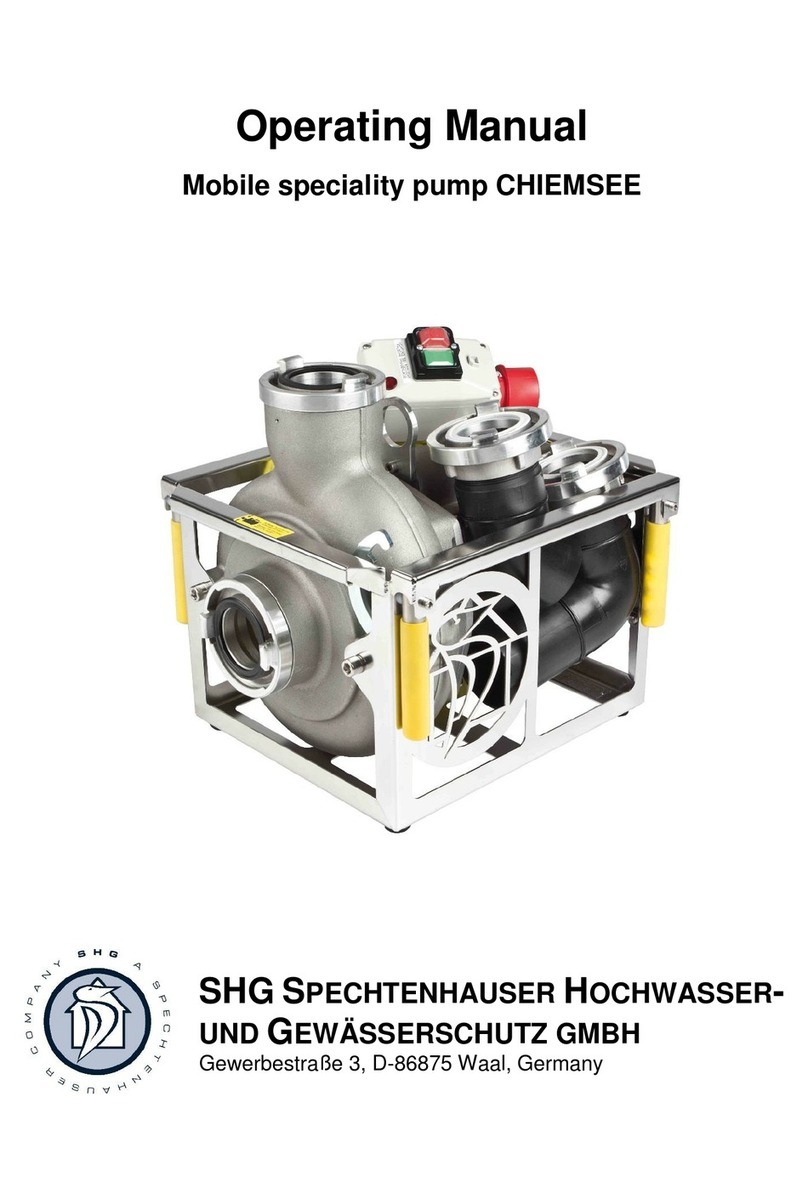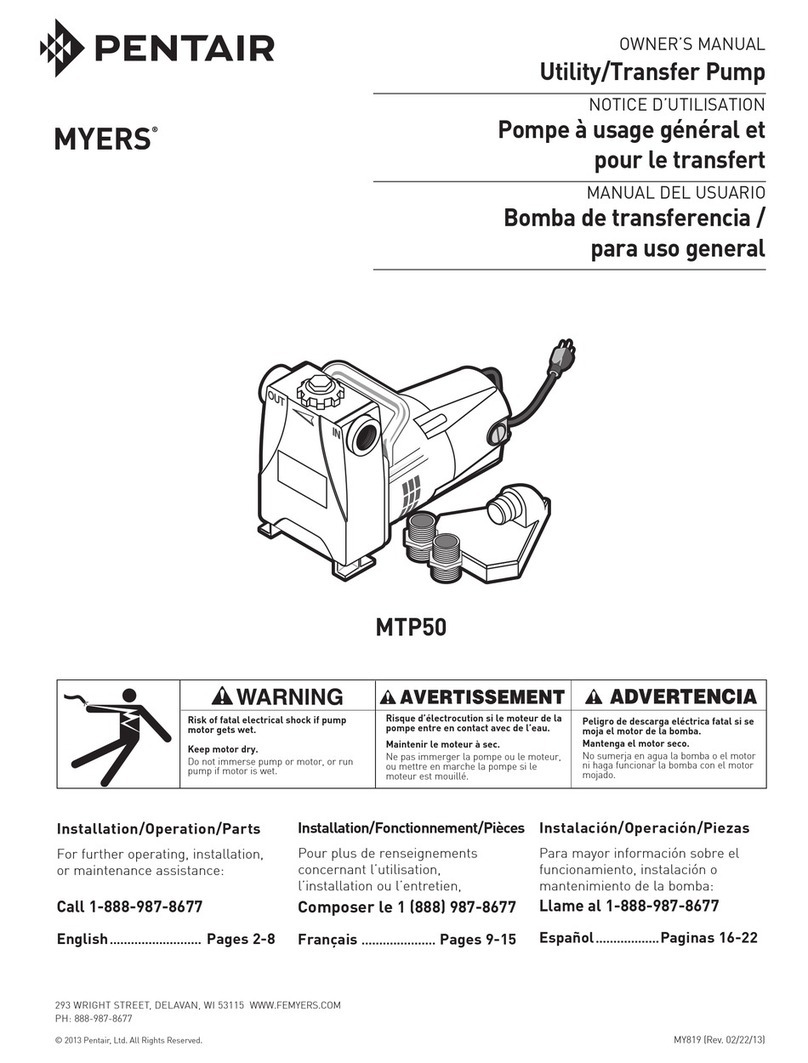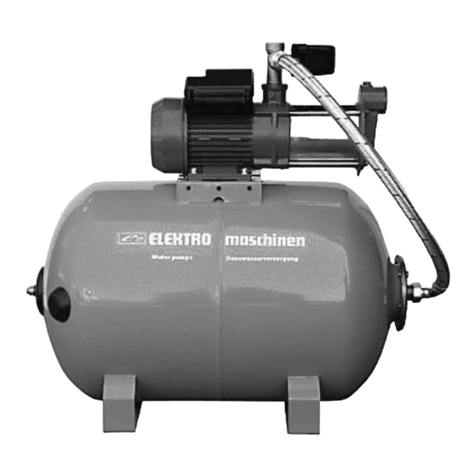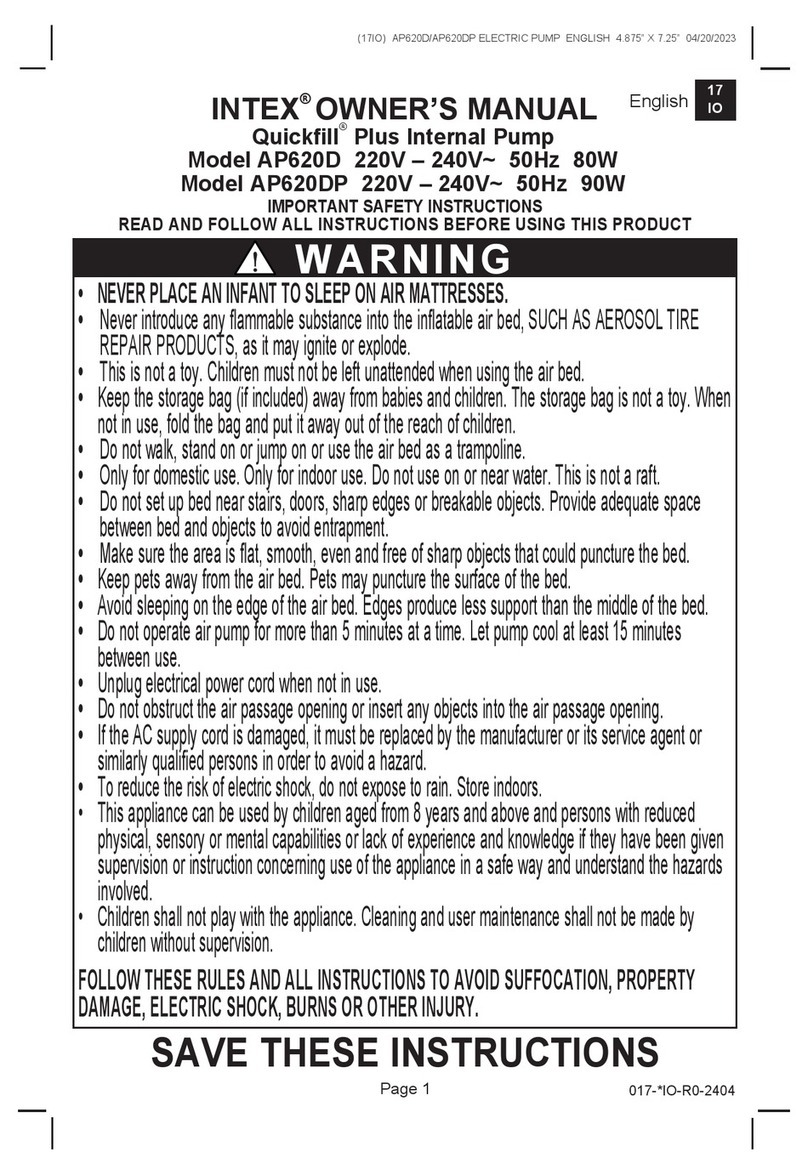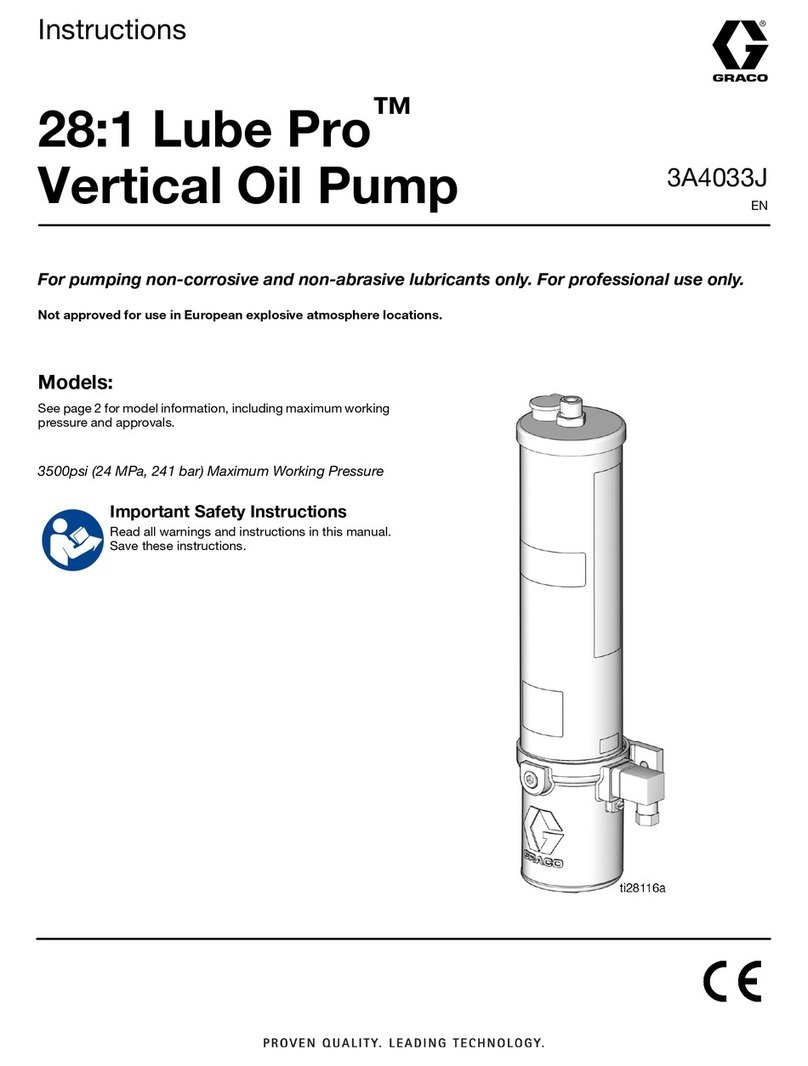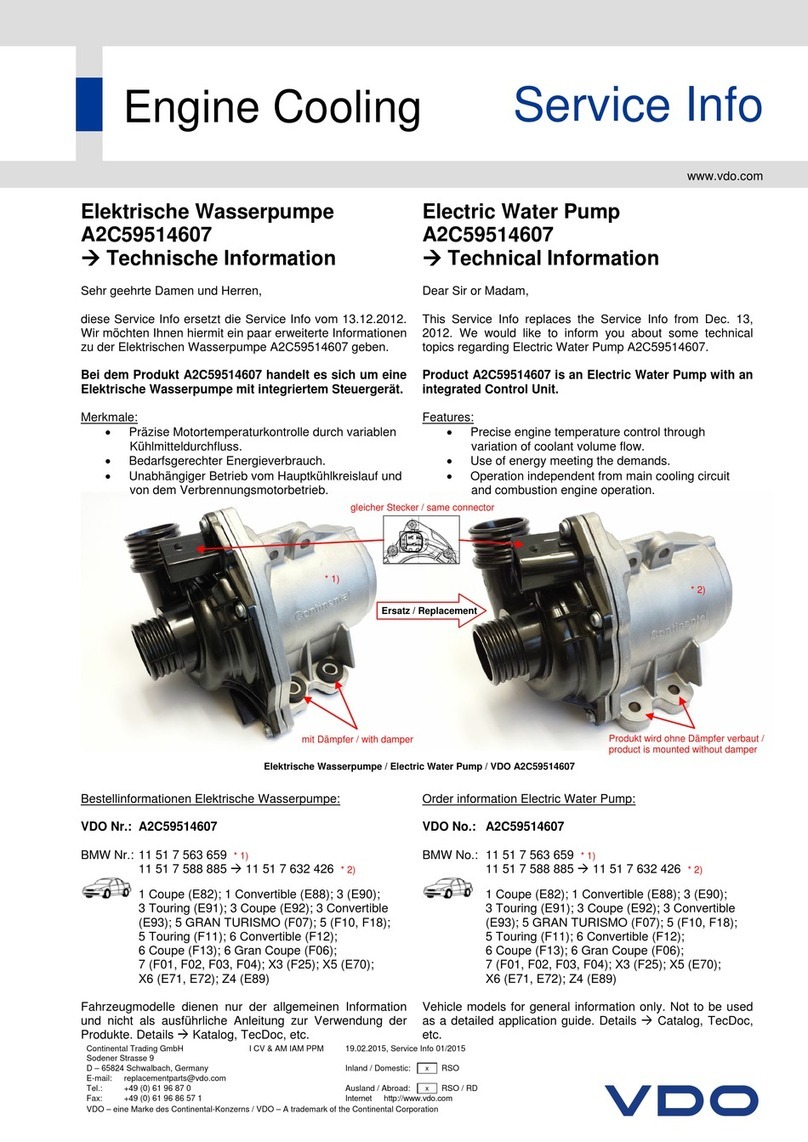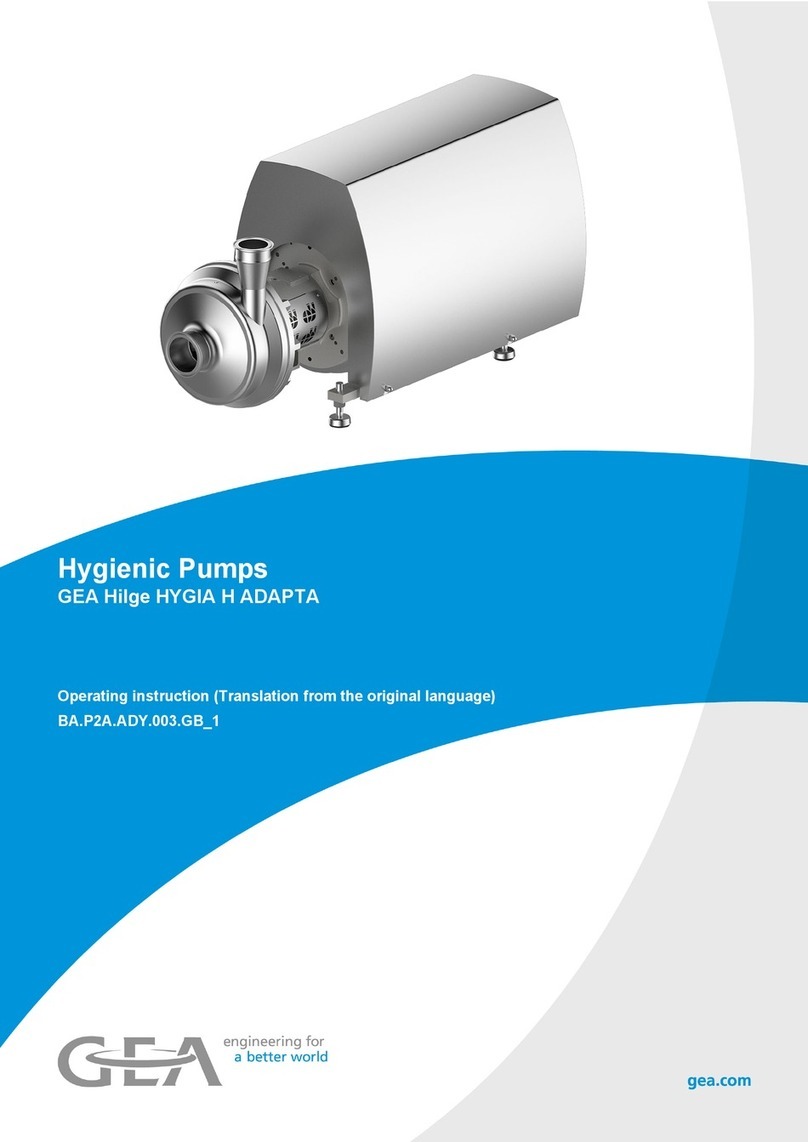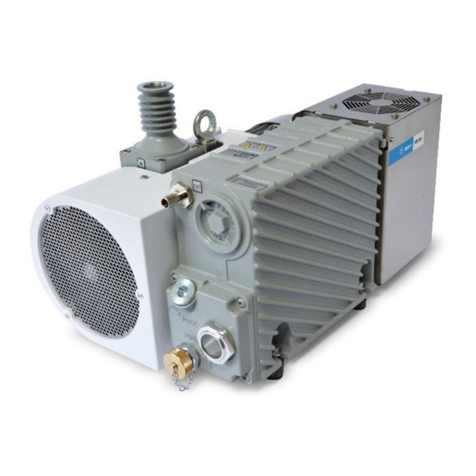SHG Atlantica User manual

Operating manual:
Mobile speciality pump Atlantica
SHG SPECHTENHAUSER HOCHWASSER-
UND GEWÄSSERSCHUTZ GMBH
Gewerbestraße 3, D-86875 Waal, Germany

Operating manual: Mobile speciality pump Atlantica
SHG SPECHTENHAUSER HOCHWASSER-UND GEWÄSSERSCHUTZ GMBH
Gewerbestraße 3, D-86875 Waal, Germany www.spechtenhauser.de
Tel.: +49 (0)8246.9695-20 shg@spechtenhauser.de
Fax: +49 (0)8246.9695-24 27.02.14 [5]
1
Table of contents
1General information ______________________________________________________________________ 2
1.1 Versions _____________________________________________________________________________ 2
1.2 Marking of the pumps_________________________________________________________________ 2
1.3 Application___________________________________________________________________________ 2
2Safety instructions _______________________________________________________________________ 3
2.1 Markings and symbols in this operating instructions ____________________________________ 3
2.2 Qualifications of personnel____________________________________________________________ 3
2.3 Hazards in the event of non-compliance with the safety instructions______________________ 3
2.4 Safety regulations for owner/operator __________________________________________________ 4
2.5 Safety instructions relevant for operation_______________________________________________ 4
2.6 Safety instructions relevant for maintenance, inspection and assembly work______________ 4
2.7 Unauthorized modifications and manufacturing of spare parts ___________________________ 5
2.8 Unauthorised modes of operation______________________________________________________ 5
3Technical data____________________________________________________________________________ 6
3.1 Equipment and weight ________________________________________________________________ 6
3.2 Engine data __________________________________________________________________________ 6
3.3 Performance _________________________________________________________________________ 6
3.4 Capacity-head table___________________________________________________________________ 6
3.5 Materials_____________________________________________________________________________ 7
3.6 Dimensions __________________________________________________________________________ 7
3.7 Description __________________________________________________________________________ 7
4Operating the pump ______________________________________________________________________ 8
4.1 Operating the pump __________________________________________________________________ 8
4.2 Series connection of Atlantica pumps_________________________________________________ 10
4.3 Using the wheel set__________________________________________________________________ 10
5Accessories_____________________________________________________________________________ 11
6Service and Maintenance_________________________________________________________________ 12
6.1 Maintenance Intervals________________________________________________________________ 12
6.2 Engine______________________________________________________________________________ 12
6.3 Dismantling the impeller _____________________________________________________________ 13
6.4 Assembling the impeller _____________________________________________________________ 14
6.5 Dismantling the V-ribbed belt_________________________________________________________ 15
6.6 Mounting the V-ribbed belt ___________________________________________________________ 16
7Problems / faults ________________________________________________________________________ 19

Operating manual: Mobile speciality pump Atlantica
SHG SPECHTENHAUSER HOCHWASSER-UND GEWÄSSERSCHUTZ GMBH
Gewerbestraße 3, D-86875 Waal, Germany www.spechtenhauser.de
Tel.: +49 (0)8246.9695-20 shg@spechtenhauser.de
Fax: +49 (0)8246.9695-24 27.02.14 [5]
2
1General information
Dear Customer,
Thank you for your decision to purchase and install this top quality product. Please follow
these operating instructions, especially those concerning safety: They are there for your
safety, will save you trouble and guard from loss of guarantee.
1.1 Versions The following versions of ATLANTICA pumps are available:
Atlantica: Pump including carrying frame, gasoline engine (Subaru) Spechten-
hauser manual double-stroke piston pump, A- or B-Storz coupling on
inlet and outlet side
Atlantica with electric starter (accessory):
Like standard Atlantica, but with gasoline engine with electric starter
and 12V battery
1.2 Marking of the pumps
Each Atlantica pump is marked by a nameplate:
Field 1: Manufacturer Field 5: Engine power Field 9: Max. head
Field 2: Type designation Field 6: Nominal rotation speed Field 10: Year of manufacture
Field 3: Serial number Field 7: Protection class
Field 4: Max. fluid temperature Field 8: Max. capacity
1.3 Application
The mobile speciality pump ATLANTICA is designed for strongly soiled waste water or
sewage including solids or long fibres in case of flood control, flooding, pipe bursts or wa-
ter level reduction. It is blockage-free for solids up to 70-80 mm in size. The pumps are
designed for mobile use. For permanent fixed installation the use of sewage pumps made
of cast iron is recommended.
Field 8Field 5 Field 6 Field 10
Field 7
Field 3
Field 1
Field 9
Field 4
Field 2

Operating manual: Mobile speciality pump Atlantica
SHG SPECHTENHAUSER HOCHWASSER-UND GEWÄSSERSCHUTZ GMBH
Gewerbestraße 3, D-86875 Waal, Germany www.spechtenhauser.de
Tel.: +49 (0)8246.9695-20 shg@spechtenhauser.de
Fax: +49 (0)8246.9695-24 27.02.14 [5]
3
2Safety instructions
(General safety instructions as per VDMA 24292)
This operation manual gives basic instructions that should be followed carefully during in-
stallation, operation and maintenance. It is essential that this manual is carefully read by
the responsible personnel/operator before assembly and commissioning. It is always to
be kept available at the installation/usage site of the pump.
2.1 Markings and symbols in this operating instructions
Safety instructions given in the user´s manual, the non-observance of which could cause
danger to life have been specifically highlighted with the general danger symbol.
The presence of dangerous voltage is identified with the safety symbol.
Other safety points in these instructions, the non-observance of which may endanger ma-
chinery or its operation, are marked as follows.
Symbols directly on the pump itself, e.g.
Direction of rotation
Type plate
must be carefully observed and must be maintained in legible condition.
2.2 Qualifications of personnel
An authorized (certified) electrician and mechanic shall carry out all work. Scope of re-
sponsibility and supervision of the personnel must be exactly defined by the operator. If
the staff does not have the necessary knowledge, they must be trained and instructed,
which may be performed by the manufacturer or supplier on behalf of the operator, more-
over, the operator is to make sure that the contents of the operating manual are fully un-
derstood by the personnel.
Minimum requirements for the operating personnel:
Legal age
Firefighter training in accordance with the fire service regulation 2 and additional
instruction of the trained machinist or "Technical Assistance" course in accord-
ance with fire service regulation 2 or
basic training Level I (German THW) as a rescue worker
Minimum requirements for the maintenance and inspection personnel:
Legal age
Qualified electrician
2.3 Hazards in the event of non-compliance with the safety instructions
Non-compliance with the safety instructions may produce a risk to the personnel as well
as to the environment and the machine and results in a loss of any right to claim damag-
es or compensation. For example, non-compliance may involve the following hazards:
Failure of important functions of the pump
Failure of specified procedures of maintenance and repair
Exposure of people to electrical, mechanical and chemical hazards
Endangering the environment owing to hazardous substances being released

Operating manual: Mobile speciality pump Atlantica
SHG SPECHTENHAUSER HOCHWASSER-UND GEWÄSSERSCHUTZ GMBH
Gewerbestraße 3, D-86875 Waal, Germany www.spechtenhauser.de
Tel.: +49 (0)8246.9695-20 shg@spechtenhauser.de
Fax: +49 (0)8246.9695-24 27.02.14 [5]
4
2.4 Safety regulations for owner/operator
All safety instructions contained in this manual, all relevant national and local health and
safety codes and any other service and safety instructions issued by the owner shall be
complied with.
2.5 Safety instructions relevant for operation
Always follow these safety instructions before using the pump:
Danger of electric shock:
Protect plug-and-socket connections against moisture and increasing water levels in
flood areas.
When using the pump in swimming pools or ponds and the surrounding area
DIN/VDE 0100 must be complied with.
Hazards resulting from electricity are to be prevented (see for example, the national-
specifications or the regulations of your local electricity supply company)
General danger
If hot or cold machine components involve hazards, they must be guarded against
accidental contact.
Guards for moving parts (e.g. couplings, nozzles) must not be removed from the ma-
chine while in operation.
In dry-well installation (suction mode) the motor housing heats up after a lengthy op-
erating period. You must therefore only use the hinged handles provided on the pump
transport cage to transport the pump and avoid direct contact with the motor housing.
Always wear protective gloves too.
When pumping hot fluids the pump always becomes as hot as the pumped fluid. In
this case you must only touch the pump if you are wearing suitable protective gloves.
In pumping mode strong suction is produced at the intake area of the pump. It is
therefore necessary to ensure that while the pump is running you never allow your
hands, feet, loose clothing (e.g. ties) or jewellery (e.g. chains) to get into the area of
the pump intake (suction side) or pump discharge (pressure side). There is risk of
shearing injuries or getting tangled.
The protection against contact (intake ports) for moving parts (impeller) may not be
removed if the machines are in operation. The pump itself may not be operated with-
out the appropriate protection against contact.
Any leakage of hazardous (e.g. explosive, toxic, hot) fluids (e.g. from the shaft seal)
must be drained away so as to prevent any risk to persons or the environment. Statu-
tory regulations are to be complied with.
Damage of the pump due to inappropriate use:
Store the pump in dry rooms only. If kept dry and clean the pump can be stored down
to a minimum temperature of –20°C. The flooded pump must not freeze.
Always use the carrying handles or the transport cart to transport the pump.
Never lift or lower the pump by the power cable or connected hoses. Always use
chains or suitable ropes.
The pump must not be excessively tilted as operating liquid could otherwise run out
of the engine. See the Engine Subaru User Manual for further details.
2.6 Safety instructions relevant for maintenance, inspection and assembly work
It shall be the user’s responsibility to ensure that all maintenance, inspection and assem-
bly work is performed by authorized and qualified personnel who have adequately famil-
iarized themselves with the subject matter by studying this manual in detail.
Any work on the machine shall only be performed when it is at stand-still, it is being im-
perative that the procedure for shutting down the machine described in this manual as
well as in the operating manual engine Subaru be followed. Pumps and pump units which
convey hazardous media must be decontaminated. All waste emissions such as used oil
must be appropriately disposed of, oil spills must be cleaned up and emissions to the en-

Operating manual: Mobile speciality pump Atlantica
SHG SPECHTENHAUSER HOCHWASSER-UND GEWÄSSERSCHUTZ GMBH
Gewerbestraße 3, D-86875 Waal, Germany www.spechtenhauser.de
Tel.: +49 (0)8246.9695-20 shg@spechtenhauser.de
Fax: +49 (0)8246.9695-24 27.02.14 [5]
5
vironment must be reported. On completion of work all safety and protective facilities
must be reinstalled and made operative again.
Before restarting, the points listed in section 4 Operating the Pump are to be observed.
2.7 Unauthorized modifications and manufacturing of spare parts
Any modification may be made to the pump only after consultation with the manufacturer.
Using spare parts and accessories authorised by the manufacturer is in interest of safety.
Use of other parts may exempt the manufacturer from any warranty or compensation
claims.
2.8 Unauthorised modes of operation
The reliability of the pump delivered will be only guaranteed if it is used in the manner in-
tended, in accordance with this manual. The limit values specified in the data sheet must
under no circumstances be exceeded. These installation and operation instructions do
not supersede or exclude generally valid regulation and standards.

Operating manual: Mobile speciality pump Atlantica
SHG SPECHTENHAUSER HOCHWASSER-UND GEWÄSSERSCHUTZ GMBH
Gewerbestraße 3, D-86875 Waal, Germany www.spechtenhauser.de
Tel.: +49 (0)8246.9695-20 shg@spechtenhauser.de
Fax: +49 (0)8246.9695-24 27.02.14 [5]
6
3Technical data
3.1 Equipment and weight
Type
Atlantica A
Atlantica B
Inlet: A-Storz B-Storz
Outlet: A-Storz B-Storz
Max. solid passage: 80 mm 70 mm
Max. temp. of liquid: 0° - 40 °C 0° - 40 °C
Weight (dry): 66 kg 65 kg
Weight (ready-to-operate) 71 kg 70 kg
3.2 Engine data
Type
Atlantica A
Atlantica B
Type of engine: 4-stroke OHC
gasoline engine 4-stroke OHC
gasoline engine
Continuous power: 5,1 kW
7,0 HP 5,1 kW
7,0 HP
Fuel tank capacity: 6,1 l 6,1 l
Rotation speed: 3600 rpm 3600 rpm
3.3 Performance
Head [bar]
0
0,2
0,4
0,6
0,8
1,0
1,2
1,6
Atlantica A
Capacity
2300 2130 1950 1750 1530 1300 1000 330
Atlantica B
[l/min]
1800 1670 1540 1370 1170 940 720 240
3.4 Capacity-head table
0,0
0,1
0,2
0,3
0,4
0,5
0,6
0,7
0,8
0,9
1,0
1,1
1,2
1,3
1,4
1,5
1,6
1,7
1,8
1,9
0 100 200 300 400 500 600 700 800 900 1000 1100 1200 1300 1400 1500 1600 1700 1800 1900 2000 2100 2200 2300 2400
Capacity [l/min]
Head [bar]
Atlantica B
Atlantica A

Operating manual: Mobile speciality pump Atlantica
SHG SPECHTENHAUSER HOCHWASSER-UND GEWÄSSERSCHUTZ GMBH
Gewerbestraße 3, D-86875 Waal, Germany www.spechtenhauser.de
Tel.: +49 (0)8246.9695-20 shg@spechtenhauser.de
Fax: +49 (0)8246.9695-24 27.02.14 [5]
7
3.5 Materials
All housing parts made of aluminium alloy (except engine, see operating manual en-
gine Subaru), bearing block made of galvanized steel
All screw connections made of stainless steel
Impeller made of wear-resistant and self-cleaning aluminium bronze
Sealing with dry run and endurance run suitable double mechanical seal made
SiC/SiC und SiC/carbon
Carrying frame made of stainless steel
3.6 Dimensions
L x W x H: 755 x 530 x 660 mm
3.7 Description
Suction cover
with inspection
glass
Check valve
Piston pump /
Vacuum pump
Motor ON / OFF
Engine
Spiral casing
Basket
Carry
ha
n
dles
Drain screw
Suction side
Attachment suction
cover

Operating manual: Mobile speciality pump Atlantica
SHG SPECHTENHAUSER HOCHWASSER-UND GEWÄSSERSCHUTZ GMBH
Gewerbestraße 3, D-86875 Waal, Germany www.spechtenhauser.de
Tel.: +49 (0)8246.9695-20 shg@spechtenhauser.de
Fax: +49 (0)8246.9695-24 27.02.14 [5]
8
4Operating the pump
Caution:
The pump may only be used in accordance with the instructions in this operation manual.
Note:
Before using the pump, check that the engine has been filled with petrol. Filling during
operation is strictly forbidden.
Danger from electric shock:
Bring electrical plug connections to a flood-proof area to protect them from water. Watch
out for rising water levels in flood areas!
Caution:
For outdoor use, the provisions of EN 60 335-2-41 must be observed.
Danger from electric shock:
No-one should be present inside the pumping medium when the pump is in operation.
4.1 Operating the pump
For safe working on and with the pump, the wearing of safety shoes and safety gloves is
recommended, in order to prevent injury from crushing or cutting.
Each time when using the pump, also ensure the following points:
1. Transport the pump to the place of use.
Caution:
Always transport the pump with the handles provided for this purpose only.
2. Mount the suction cover with inspection glass to the pressure side of the pump and
connect the suction cover to the corresponding connection. This guarantees that the
piston pump is able to generate negative pressure for suctioning. The suction cover
is to be checked for functionality and impurities before assembling, and fixed if nec-
essary. Furthermore, ensure that the pump is sitting evenly on stable ground and
that the engine is dry (see Engine Safety, Engine User Manual).
Caution:
Only the suction cover from Spechtenhauser is to be used. Suction operation with
other suction cover is not possible. Only use a transparent suction hose as a suction
hose.
Danger:
The dimensionally stable spiral hoses for using the pump, as well as the suction
cover, must be fitted on the pressure and / or suction side before use. They serve as
impact protection for the impeller. The pumps themselves may not be operated with-
out the appropriate contact protection. Ensure the absence of foreign objects in the
pump and hoses before operating.
3. In case of the delivered check valve, a leash can be attached to the venting ring for
venting the suction line. When the leash is attached, it is to be ensured that it is 1.5
m longer than the depth of immersion of the suction hose to be employed
4. Fit a transparent, dimensionally stable spiral hose with A or B Storz connection to
the suction side of the pump. For suction with the reciprocating piston pump, the

Operating manual: Mobile speciality pump Atlantica
SHG SPECHTENHAUSER HOCHWASSER-UND GEWÄSSERSCHUTZ GMBH
Gewerbestraße 3, D-86875 Waal, Germany www.spechtenhauser.de
Tel.: +49 (0)8246.9695-20 shg@spechtenhauser.de
Fax: +49 (0)8246.9695-24 27.02.14 [5]
9
open end of the hose must be coupled with the Spechtenhauser check valve, and in
this case, for the suction process, the check valve, with the opening flap, must be lo-
cated completely in the medium. For suction, the hose must not take in any air.
Caution:
When placing the transparent, dimensionally stable spiral hoses (suction side) in the
liquid, it must be ensured that the engine is not splashed and that it does not be-
come wet. In addition, the hose should be laid as much as possible with no kinks or
bends.
Caution:
Only the check valve from Spechtenhauser is to be used. Suction operation with ball
flap valves is not possible. Only use a transparent suction hose as a suction hose.
5. Make sure that the pump is standing safely.
Danger:
Before starting work with the pump, it must be ensured that the pump is still standing
evenly on solid ground after fitting the hoses, in order to guarantee trouble-free op-
eration of the pump.
6. Ensure that the engine is switched off. For this purpose the red knob on the engine
must be set to off. Then check the oil and petrol level and fill if necessary. Please al-
so read the safety notes in the Engine Subaru User Manual.
Danger due to deflagration:
Oil and petrol may never be refilled when the pump is operating. Similarly, ensure
that the engine is not too hot while filling (previous pump operation). Please refer to
the Engine Subaru User Manual for exact engine filling instructions.
7. Fill the pump system (suction hose and spiral casing) by activating the Spechten-
hauser reciprocating piston pump with water. For this, the following points are to be
observed.
Caution:
By using the Spechtenhauser reciprocating piston pump with a transparent suction
hose, check valve and suction cover, self-suction of the pump is possible. All cou-
plings used on the suction side must be clean and leak-proof. As soon as air is able
to enter the system on the suction side, pumping is no longer possible. Suction is on-
ly possible with pumping liquid of max. 40 C.
8. Ensure that the stopcock is open and that the hose which leads from the reciprocat-
ing piston pump to the suction cover is not blocked.
9. Lay the suction hose with non-return valve in the medium to be pumped. Ensure that
do not insert the end of the leash into the medium. Furthermore, note that the check
valve is not located on the ground, rather approx. 20 cm above the ground. It is
avoided that stones and so forth are sucked in
10. Now pump using the reciprocating piston pump until the spiral casing is completely
filled with water. During the suction procedure, watch the rising water column in the
transparent hose. Once the water column has fully reached the spiral casing, the
suction process has been concluded. Sucking water into the suction hose of the re-
ciprocating piston pumps is to be avoided under all circumstances. The suction pro-
cess is to be ended before water can be sucked into the suction pipe
Important:
The non-return valve must be loaded with at least 1.5 m water column so that it is
completely watertight.

Operating manual: Mobile speciality pump Atlantica
SHG SPECHTENHAUSER HOCHWASSER-UND GEWÄSSERSCHUTZ GMBH
Gewerbestraße 3, D-86875 Waal, Germany www.spechtenhauser.de
Tel.: +49 (0)8246.9695-20 shg@spechtenhauser.de
Fax: +49 (0)8246.9695-24 27.02.14 [5]
10
11. Now loosen the suction cover from the coupling and place this onto the receptacle
on the support frame during the operation. The water column is retained by the
check valve. Now fix a transparent spiral hose or a 90° elbow on the pressure side of
the pump. A suitable fire hose can now be connected to this 90° elbow or this spiral
hose. Lay this at a suitable drain or collection tank. The end of the pressure hose
must be adequately secured against impact. The fire hose should be laid without
kinks, where possible, to achieve an optimum pumping power. It is strongly recom-
mended that you use the optional dimensionally stable spiral pressure hose for the
first 3 - 5m.
Danger:
Ensure that the pressure hose end is adequately secured and fixed. Otherwise,
there is the risk of the hose end being hit when switching on the pump.
12. The suction procedure is now complete and the pump is ready for starting the en-
gine.
13. Now check the shock on the engine and set it to ignition.
14. Turn the pump on by switching on the red power button and then pulling the reverse
starter to start the engine (with E-start, turn the ignition key). Please refer to the En-
gine Subaru User Manual for more information on starting the engine. The ball valve
can now be opened once the engine is running and the water column is there. The
engine can now run at full power using the throttle. The pump should now deliver
with the specified flow rate.
15. Switch off the pump again by turning the red knob as soon as the water level has
fallen so far that the pump intakes air. Please refer to the Engine Subaru User Man-
ual for more information on turning off the engine.
16. Pull on the leash of the check valve so that the remaining water column can run off.
Dismantling of the hoses after end of use
17. Clean the pump with clear water after each use, particularly after using it with muddy
liquid. In addition, let the pump run for about 10 minutes with clean water. The pump
is to then be completely emptied.
18. Drain the rest of the remaining water in the spiral casing using the drain plug. Un-
screw the drain plug and wait until no more water comes and screw it closed again.
19. For transport, the suction cover must be again placed onto the pump and fixed cou-
pled.
4.2 Series connection of Atlantica pumps
To achieve pumping heights of over 15 m, series connection of Atlantica pumps is possi-
ble. With this, the pressure side of the first Atlantica is connected to the next Atlantica
over a dimensionally stable hose.
4.3 Using the wheel set
The Atlantica pumps can also be delivered with an optional set of wheels for easier
transport. Before using them, check the wheels for stability (tightened screws and nuts).
The pumps may only be lifted onto the supporting frame (tilt angle max. 45 ) and pulled
by the handles. If the set of wheels are to be dismantled, remove the four screws and
bring the Atlantica pump down using the handles provided for this. When refitting the set
of wheels, ensure that the holes in the handles are aligned to the holes on the wheel set.
Caution:
If pulled too quickly, the pump can rock and overturn (damage to the pump). Ensure that
the speed is appropriate. The pump should be moved on solid ground.

Operating manual: Mobile speciality pump Atlantica
SHG SPECHTENHAUSER HOCHWASSER-UND GEWÄSSERSCHUTZ GMBH
Gewerbestraße 3, D-86875 Waal, Germany www.spechtenhauser.de
Tel.: +49 (0)8246.9695-20 shg@spechtenhauser.de
Fax: +49 (0)8246.9695-24 27.02.14 [5]
11
5Accessories
The following accessories are available for the Atlantica mobile special pump.
PCV suction hose with associated A or B Storz connection,
90 arc in A or B Storz model
E-Start with 12 V battery
Work lights only in connection with E-Start
Wheel set
Other coupling systems
V-ribbed belt test device
Please contact your specialist dealer for questions about accessories.

Operating manual: Mobile speciality pump Atlantica
SHG SPECHTENHAUSER HOCHWASSER-UND GEWÄSSERSCHUTZ GMBH
Gewerbestraße 3, D-86875 Waal, Germany www.spechtenhauser.de
Tel.: +49 (0)8246.9695-20 shg@spechtenhauser.de
Fax: +49 (0)8246.9695-24 27.02.14 [5]
12
6Service and Maintenance
It shall be the user’s responsibility to ensure that all maintenance, inspection and assembly work is per-
formed by authorized and qualified personnel who have adequately familiarized themselves with the subject
matter by studying this manual and the operating manual engine Subaru in detail.
Any work on the machine shall only be performed when it is at stand-still, it is being imperative that the pro-
cedure for shutting down the machine described in this manual is be followed.
Pumps and pump units which convey hazardous media must be decontaminated. All waste emissions such
as used oil must be appropriately disposed of, oil spills must be cleaned up and emissions to the environ-
ment must be reported. On completion of work all safety and protective facilities must be reinstalled and
made operative again.
6.1 Maintenance Intervals
After each use, the pump must be cleaned and maintained, i.e. it must be checked for
damage. The pumps have to be switched off and secured against restarting. The V-
ribbed belt particularly has to be changed after 500 hours of operation or no later than
every 2 years. The operating hours counter on the E-Start version is relevant for the op-
erating hours. With the version without E-start, all operating hours are to be entered in the
list provided for this at the back of the user manual.
Caution with engines:
The engines have other maintenance intervals than the pump itself. Please refer to the
engine Subaru User Manual.
6.1.1 Screw tightening torque
Screw
Screw connection
Tightening torque
M8 Impeller / shaft 34 Nm
M12 Engine / spiral housing 50 Nm
M12 Pump / basket 50 Nm
6.2 Engine With all pumps, opening of the engine is not permitted. Repairs and maintenance on the
engine may only be carried out by Spechtenhauser Customer Service, Robin Europe
(Subaru) or at the plant. For more information about Robin Europe (Subaru) dealer net-
work, please refer to the website www.robin-europe.de. In case of infringement, all claims
for warranty and damages are lost.
6.2.1 Engine with E-Start
The function of the optional E-Start is described in more detail in the engine Subaru User
Manual. A battery is screwed to the floor panel for starting the engine. The engine has a
generator which recharges the battery in operation. If the battery is to be unloaded follow-
ing a longer period of downtime, this should only be done after it is removed.
Caution:
The battery should only be changed by trained per-
sonnel or an electrician.
To remove it, loosen the two nuts and take out the
retaining bracket. Then loosen the cable. Install in
the reverse order.

Operating manual: Mobile speciality pump Atlantica
SHG SPECHTENHAUSER HOCHWASSER-UND GEWÄSSERSCHUTZ GMBH
Gewerbestraße 3, D-86875 Waal, Germany www.spechtenhauser.de
Tel.: +49 (0)8246.9695-20 shg@spechtenhauser.de
Fax: +49 (0)8246.9695-24 27.02.14 [5]
13
6.3 Dismantling the impeller
If stubborn blockages form in the spiral housing, the spiral housing and the impeller can be dismantled via
the following steps:
Caution: Work may only be carried out on it when the pump is shut down and secured
against restarting.
1. Remove the four hexagonal screws with washers (M5) and the
suspension eyelets on the stainless steel housing between the
spiral casing and the engine.
2. Remove the stainless steel cover.
3. Loosen the suction cover and place this to the side on the
support frame, so that you can work without any hindrance
from the suction cover
4. Remove the four cylindrical screws with the hexagon socket
(M12), inside the pedestal, from the motor flange to the spiral
casing.
(The picture only shows the two bottom screws; the other two
screws are positioned above.)
5. Remove the spiral casing. With
stubborn blockages, it may be
necessary to remove the spiral
casing with the help of two
screwdrivers. To do so, place
the screwdriver on the two
designated slots on the spiral
casing and lift the spiral casing
out. To remove the supporting
frame, you have to turn the
spiral casing by 90 - 45 and
take it out.
6. Remove the countersunk screw with torx (M8) from the impel-
ler.
7. Pull the impeller out of the shaft. After the impeller is removed
from the shaft, the polygon connection has to be checked for
damage.

Operating manual: Mobile speciality pump Atlantica
SHG SPECHTENHAUSER HOCHWASSER-UND GEWÄSSERSCHUTZ GMBH
Gewerbestraße 3, D-86875 Waal, Germany www.spechtenhauser.de
Tel.: +49 (0)8246.9695-20 shg@spechtenhauser.de
Fax: +49 (0)8246.9695-24 27.02.14 [5]
14
6.4 Assembling the impeller
When assembling the impeller, the following steps are to be taken:
Caution: Work may only be carried out on it when the pump is shut down and secured against
restarting.
1. Before assembly, clean the impeller, the engine flange and the polygon connection. Check all com-
ponents for damage.
2. Attach the O-ring which is available as a spare part to
the motor flange.
3. Evenly place the impeller, appropriate for the polygon
connection, on the engine shaft and push it down until it
stops. (impression depth: 27 mm)
4. Screw the impeller with the engine shaft using the
countersunk screw with torx (M8). To fasten the
screws, high-strength screw locking (Loctite) is to be
used. Please refer to Table 6.1.1 Screw Tightening
Torque for the correct screw tightening torque.
5. Place the spiral casing above the mounted impeller on
the motor flange and press it onto the motor flange.

Operating manual: Mobile speciality pump Atlantica
SHG SPECHTENHAUSER HOCHWASSER-UND GEWÄSSERSCHUTZ GMBH
Gewerbestraße 3, D-86875 Waal, Germany www.spechtenhauser.de
Tel.: +49 (0)8246.9695-20 shg@spechtenhauser.de
Fax: +49 (0)8246.9695-24 27.02.14 [5]
15
6. Tightly screw the four cylindrical screws with the hexa-
gon socket (M12), inside the pedestal, from the engine
flange to the spiral casing.
(Only the two screws below are shown in the image)
To fasten the screws, medium-strength screw locking
(Loctite) is to be used. Please refer to Table 6.1.1
Screw Tightening Torque for the correct screw tighten-
ing torque.
Insert the stainless steel cover between the spiral cas-
ing and the engine and tightly screw the four hexago-
nal screws with washers (M5) and the suspension eye-
lets.
7. Place the suction cover onto the pump again
Please refer to Table 6.1.1 Screw Tightening Torque for the
correct screw tightening torque.
6.5 Dismantling the V-ribbed belt
The belt must be changed after 500 hours. In addition, changes can be required due to shifting or tearing on
the belt extreme stress. The V-ribbed belt can be disassembled by means of the following steps:
Caution: Work may only be carried out on it when the pump is shut down and secured against
restarting.
1. First, you need to remove the stainless steel cover and spiral casing. For these points, please refer to
section 6.3 points 1 to 5.
2. Loosen the belt tensioner screw so that you can remove
the whole belt tensioner. Take the spring out of the hold-
er at the belt tensioner and the tensioning screw.
3. Take the V-ribbed belt out of the sprocket of the V-ribbed
disks. To do this, push forward against the direction of
the V-ribbed belt and in the direction of the impeller and
turn the shaft. The V-ribbed belt goes down through the
pressure and repeated rotation.

Operating manual: Mobile speciality pump Atlantica
SHG SPECHTENHAUSER HOCHWASSER-UND GEWÄSSERSCHUTZ GMBH
Gewerbestraße 3, D-86875 Waal, Germany www.spechtenhauser.de
Tel.: +49 (0)8246.9695-20 shg@spechtenhauser.de
Fax: +49 (0)8246.9695-24 27.02.14 [5]
16
Caution: Danger due to trapping of limbs.
4. Loosen the four cylindrical screws with the hexagon
socket (M8) on the pedestal to the motor flange.
(Only two of the four screws are visible on the image;
the other screws are located opposite)
5. Drive the engine flange out of the pedestal using a
plastic hammer until the entire unit is removed.
6. Remove the V-ribbed belt from the pedestal and replace it. Ensure that the clamping ring is in the rear
pedestal seat. If it has fallen out, put it back in again.
6.6 Mounting the V-ribbed belt
When assembling the impeller, the following steps are to be taken:
Caution: Work may only be carried out on it when the pump is shut down and secured
against restarting.
1. Lay the new V-ribbed belt in the pedestal and ensure
that V-ribbed belt is also threaded when inserting the
unit. Ensure that the clamping ring is in the rear pedestal
seat and properly laid.

Operating manual: Mobile speciality pump Atlantica
SHG SPECHTENHAUSER HOCHWASSER-UND GEWÄSSERSCHUTZ GMBH
Gewerbestraße 3, D-86875 Waal, Germany www.spechtenhauser.de
Tel.: +49 (0)8246.9695-20 shg@spechtenhauser.de
Fax: +49 (0)8246.9695-24 27.02.14 [5]
17
2. Place the engine flange on the pedestal, ensuring that
the shaft is inserted evenly into the pedestal seat.
3. Tightly screw the four cylindrical screws with the hexa-
gon socket (M8) on the pedestal to the engine flange.
(Only two of the four screws are visible on the image;
the other screws are located opposite)
4. Insert the V-ribbed belt in the sprocket of the V-ribbed
disks. To do this, push backward against the direction of
the V-ribbed belts and in the direction of the engine and
turn the shaft. The V-ribbed belt enters the grooves of
the V-ribbed disks through the pressure and repeated ro-
tation.
5. Loosen the clamp screw so you can insert the belt ten-
sioner and the spring. Make sure that the spring in the
holder of the tensioning screw is exactly inserted and
guided. Screw on the belt tensioner, but not tightly as it
still has to be adjusted.
6. Due to the tension of the spring the belt tensioner is
pressed against the V-ribbed belt. A belt tension of 160
Hertz (+- 5 Hertz) is needed and this must be strictly ad-
hered to. The required belt tension can be adjusted by
tightening or loosening the tensioning screw. The V-
ribbed belt test device is available as an option for meas-
uring accuracy.
Tensioning screw
Belt tensioner
Spring

Operating manual: Mobile speciality pump Atlantica
SHG SPECHTENHAUSER HOCHWASSER-UND GEWÄSSERSCHUTZ GMBH
Gewerbestraße 3, D-86875 Waal, Germany www.spechtenhauser.de
Tel.: +49 (0)8246.9695-20 shg@spechtenhauser.de
Fax: +49 (0)8246.9695-24 27.02.14 [5]
18
7. Counter the tension screw using the nut above the floor panel. Then tightly screw the belt tensioner to
the engine.
8. You now need to mount the stainless steel cover and spiral housing. For these points, please refer to
section 6.4 points 5 to 8.

Operating manual: Mobile speciality pump Atlantica
SHG SPECHTENHAUSER HOCHWASSER-UND GEWÄSSERSCHUTZ GMBH
Gewerbestraße 3, D-86875 Waal, Germany www.spechtenhauser.de
Tel.: +49 (0)8246.9695-20 shg@spechtenhauser.de
Fax: +49 (0)8246.9695-24 27.02.14 [5]
19
7Problems / faults
Malfunctions, causes and fixes
Problem
Cause
Remedy
Engine does not run, stops No petrol Check the fill level.
Check the power cable for damage.
Defective power line. Check the power cable (ignition).
Overheated engine temperature. Allow the engine to cool down and
start it after resetting the electronics.
If it happens again, the engine is to
be checked by Spechtenhauser Cus-
tomer Service
Leaking engine The engine is to be checked by
Spechtenhauser Customer Service.
The engine runs, the pump does
not pump Pump or hose blocked Clean the pump or the hose.
Air in the pump. When using the suction cover, en-
sure that the suction hose and pump
are filled with water. All couplings
must be sealed. Ensure that the
check valve closes trouble-free.
Pumping power too low Pressure loss in system to high. Remove the kink in the hose or use a
hose with a larger diameter.
Flow rate too high Connect a second Atlantica in series;
so one after the other.
Hose blocked! Remove the blockage in the hose.
Viscosity of the pumped liquid
too high. Use a more powerful pump.
The pumping liquid is too thick Thin the liquid, if possible, or use a
more powerful pump.
Please refer to the Engine Subaru User Manual in case of faults and problems on the engine.
Should you have any further questions, please contact our Customer Service.
Table of contents
Other SHG Water Pump manuals
Popular Water Pump manuals by other brands

Whale
Whale BP0527 quick start guide
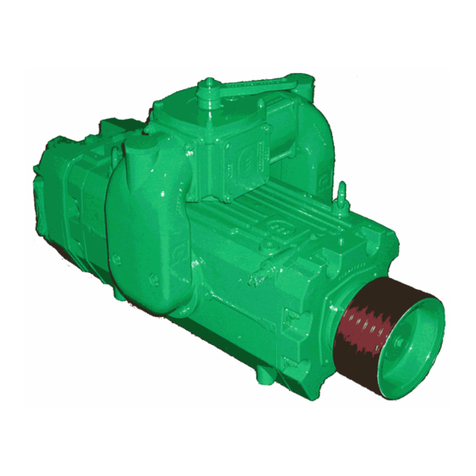
Moro
Moro PM2600 Use and maintenance manual
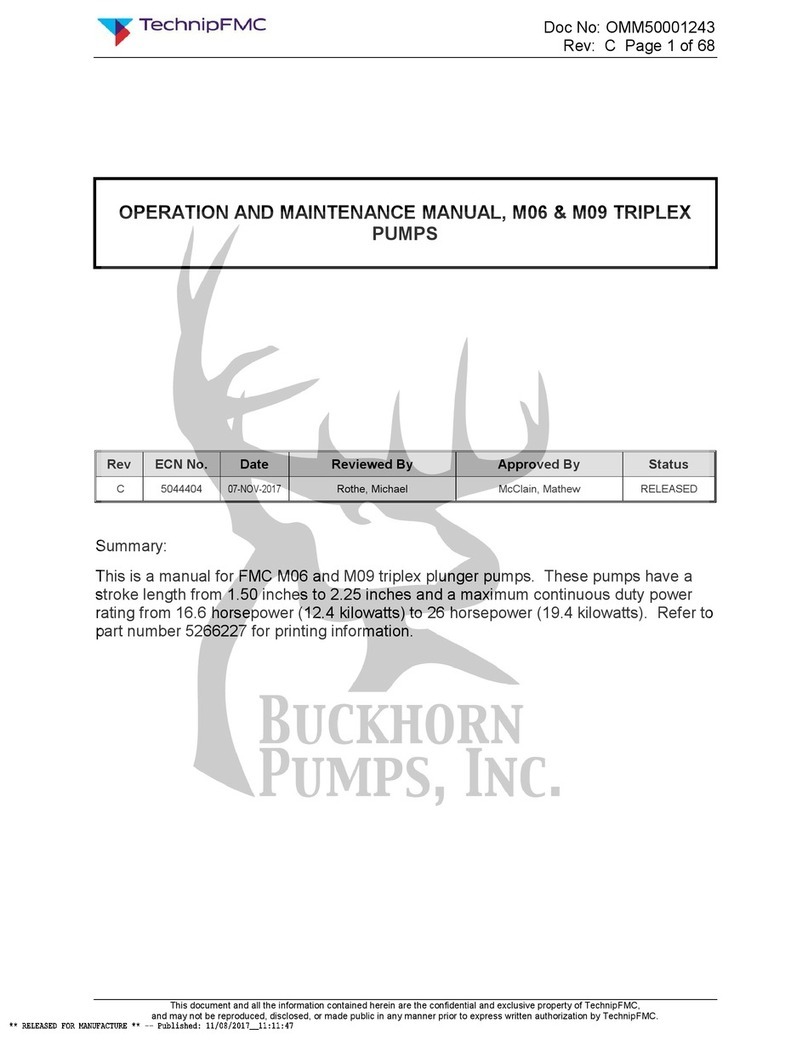
TechnipFMC
TechnipFMC TRIPLEX M06 Operation and maintenance manual
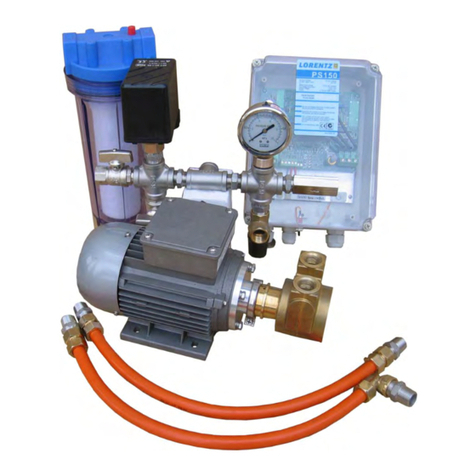
Lorentz
Lorentz PS150 Boost INSTRUCTIONS FOR INSTALLATION OPERATION SERVICE
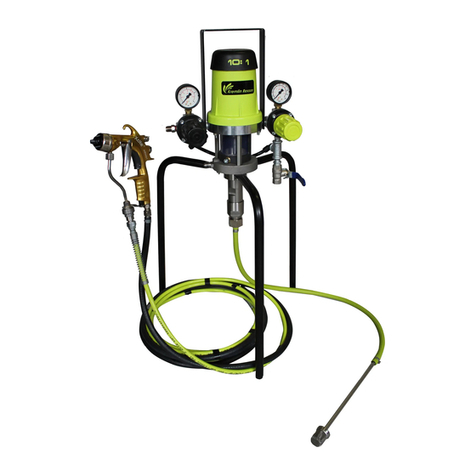
Kremlin-Rexson
Kremlin-Rexson AIRMIX EOS 10-C18 Translation from the original manual

Pfeiffer Vacuum
Pfeiffer Vacuum HENA 202 operating instructions

